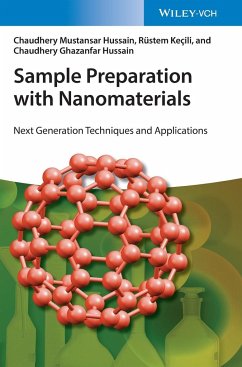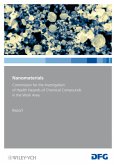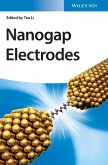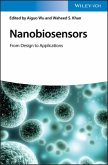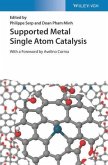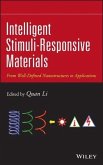Chaudhery Mustansar Hussain, Rüstem Keçili, Chaudhery Ghazanfar Hussain
Sample Preparation with Nanomaterials
Next Generation Techniques and Applications
Chaudhery Mustansar Hussain, Rüstem Keçili, Chaudhery Ghazanfar Hussain
Sample Preparation with Nanomaterials
Next Generation Techniques and Applications
- Gebundenes Buch
- Merkliste
- Auf die Merkliste
- Bewerten Bewerten
- Teilen
- Produkt teilen
- Produkterinnerung
- Produkterinnerung
The use of nanomaterials opened new perspectives also in analytical chemistry. Despite significant advances in instrumentation, sample preparation remained a bottleneck. The special features of nanomaterials such as ultra-small size and huge surface-to-volume ratio could recently be successfully implemented in sample preparation procedures. This monograph gives a comprehensive overview of these developments: From special properties of nanomaterials over physico-chemical background up to most recent and representative applications (e.g. membranes, lab-on-a-chip echnology, and SERS), all…mehr
Andere Kunden interessierten sich auch für
![Nanomaterials Nanomaterials]() Nanomaterials42,99 €
Nanomaterials42,99 €![Nanogap Electrodes Nanogap Electrodes]() Tao LiNanogap Electrodes97,99 €
Tao LiNanogap Electrodes97,99 €![Nanobiosensors Nanobiosensors]() Nanobiosensors147,99 €
Nanobiosensors147,99 €![Metal Chalcogenide Nanostructures for Renewable Energy Applications Metal Chalcogenide Nanostructures for Renewable Energy Applications]() Metal Chalcogenide Nanostructures for Renewable Energy Applications235,99 €
Metal Chalcogenide Nanostructures for Renewable Energy Applications235,99 €![Supported Metal Single Atom Catalysis Supported Metal Single Atom Catalysis]() Supported Metal Single Atom Catalysis200,99 €
Supported Metal Single Atom Catalysis200,99 €![Nanoparticles in Catalysis Nanoparticles in Catalysis]() Nanoparticles in Catalysis146,99 €
Nanoparticles in Catalysis146,99 €![Intelligent Stimuli-Responsive Materials Intelligent Stimuli-Responsive Materials]() Intelligent Stimuli-Responsive Materials219,99 €
Intelligent Stimuli-Responsive Materials219,99 €-
-
-
The use of nanomaterials opened new perspectives also in analytical chemistry. Despite significant advances in instrumentation, sample preparation remained a bottleneck. The special features of nanomaterials such as ultra-small size and huge surface-to-volume ratio could recently be successfully implemented in sample preparation procedures. This monograph gives a comprehensive overview of these developments: From special properties of nanomaterials over physico-chemical background up to most recent and representative applications (e.g. membranes, lab-on-a-chip echnology, and SERS), all important aspects are covered. Additionl chapters on toxicity, legal and environmental aspects make this book an unique reference.
Produktdetails
- Produktdetails
- Verlag: Wiley-VCH
- Artikelnr. des Verlages: 1133817 000
- 1. Auflage
- Seitenzahl: 304
- Erscheinungstermin: 27. April 2021
- Englisch
- Abmessung: 250mm x 175mm x 21mm
- Gewicht: 748g
- ISBN-13: 9783527338177
- ISBN-10: 3527338179
- Artikelnr.: 60093363
- Herstellerkennzeichnung
- Wiley-VCH GmbH
- Boschstraße 12
- 69469 Weinheim
- wiley.buha@zeitfracht.de
- 06201 6060
- Verlag: Wiley-VCH
- Artikelnr. des Verlages: 1133817 000
- 1. Auflage
- Seitenzahl: 304
- Erscheinungstermin: 27. April 2021
- Englisch
- Abmessung: 250mm x 175mm x 21mm
- Gewicht: 748g
- ISBN-13: 9783527338177
- ISBN-10: 3527338179
- Artikelnr.: 60093363
- Herstellerkennzeichnung
- Wiley-VCH GmbH
- Boschstraße 12
- 69469 Weinheim
- wiley.buha@zeitfracht.de
- 06201 6060
Chaudhery Mustansar Hussain, PhD, is an Adjunct Professor and Director of Labs in the Department of Chemistry & Environmental Sciences at the New Jersey Institute of Technology (NJIT), Newark, New Jersey, USA. His research is focused on nanotechnology, analytical chemistry, advanced technologies & materials, environmental management, and various industries. Dr. Hussain is the author of numerous papers in peer-reviewed journals as well as prolific author and editor of several (around 50 books) scientific monographs and handbooks in his research areas. Rüstem Keçili is currently an Associate Professor at the Yunus Emre Vocational School of Health Services, Anadolu University, Turkey. He worked as a researcher at MIP Technologies AB, Sweden, and was a visiting researcher at the University of Manchester, UK. His professional background covers nanomaterials, molecularly imprinted polymers and chromatography. Chaudhery Ghazanfar Hussain is a Research Scholar in Computer Science and Technology at the Department of Education, Punjab, Pakistan. His key areas of research are Data Science, Computer Networks, Environmental Modeling, nanomaterials and Industrial development. He is author of monographs on software technology. He is a true IT professional and affiliated with several companies.
1 Nanomaterials (NMs) in Analytical Sciences
1.1 Introduction
1.2 Types of NMs
1.3 Applications of NMs
1.4 Conclusions
References
2 Special Properties of Nanomaterials (NMs) for SamplePreparation
2.1 Introduction
2.2 Mechanical Properties of NMs
2.3 Thermal Properties of NMs
2.4 Electrical Properties of NMs
2.5 Optical Properties of NMs
2.6 Magnetic Properties of NMs
2.7 Adsorption Properties of NMs
2.8 Conclusions
References
3 Adsorption Mechanism on Nanomaterials (NMs)
3. 1Introduction
3.2 Adsorption Process
3.3 Conclusions and Future Perspective
References
4 Carbon Nanomaterials (CNMs) as Adsorbents for SamplePreparation
4.1 Introduction
4.2 Carbon Nanomaterials (CNMs)
4.3 Adsorption on CNMs
4.4 Applications of CNMs
4.5 Conclusions
References
5 Membrane Applications of Nanomaterials (NMs)
5.1 Introduction935.2Traditional Membranes
5.2 Traditional Membranes
5.3 Carbon Nanomaterial-based Membranes
5.4 Nanoparticle-based Membranes
5.5 Molecularly Imprinted Polymer (MIP)-based Membranes
5.6 Conclusions
References
6 Surface-Enhanced Raman Spectroscopy (SERS) withNanomaterials (NMs)
6.1 Introduction
6.2 Theory of SERS
6.3 SERS Mechanisms
6.4 Determination of SERS Enhancement Factor
6.5 Selection Rules
6.6 Fabrications of SERS Substrates
6.7 Applications of SERS
6.8 Conclusions
References
7 Nanomaterials (NMs) for Biological Sample Preparations
7.1 Introduction
7.2 The Use of NMs in Diagnostic Platforms
7.3 NMs-based Lab-on-a-chip (LOC) Platforms
7.4 Biomedical Applications of NMs
7.5 Sensor Applications of NMs
7.6 Conclusions
8 Magnetic Nanomaterials for Sample Preparation
8.1 Introduction
8.2 Synthesis of Magnetic Nanoparticles
8.3 Solid-Phase Extraction (SPE)
8.4 Magnetic Solid-Phase Extraction (MSPE)
8.5 Conclusions and Future Trends
References
9 Lab on Chip with Nanomaterials (NMs)
9.1 Introduction
9.2 Lab-on-a-Chip (LOC) Concept
9.3 NM-Based LOC Platforms
9.4 Conclusions and Future Perspectives
References
10 Toxicity and Risk Assessment of Nanomaterials
10.1 Introduction
10.2 Hazard Assessment of Nanomaterials
10.3 Toxicity Mechanism of Nanomaterials
10.4 The Traditional Risk Assessment Paradigm
10.5 Strategies for Improving Specific Risk Assessment
10.6 Conclusions
References
11 Economic Aspects of Nanomaterials (NMs) for SamplePreparation
11.1 Introduction
11.2 Toxicity Concerns of NMs
11.3 Global Market for NM-Based Products
11.4 Conclusions
References
12 Legal Aspects of Nanomaterials (NMs) for SamplePreparation
12.1 Introduction
12.2 Safety Issues of NMs
12.3 Regulatory Aspects of NMs
12.4 Conclusions
References
13 Monitoring of Nanomaterials (NMs) in the Environment
13.1 Introduction
13.2 Toxicity and Safety Concerns of NMs
13.3 Main Sources and Transport Routes of Nanopollutants
13.4 Requirements of Analytical Approaches
13.5 Sampling of NMs in Environmental Samples
13.6 Separation of NMs in Environmental Samples
13.7 Detection Techniques for the Characterization of NMs
13.8 Conclusions
References
14 Future Prospect of Sampling
14.1 Introduction
14.2 Sampling
14.3 Sample Preparation
14.4 Green Chemistry
14.5 Miniaturization of Analytical Systems
14.6 Conclusions
References
1.1 Introduction
1.2 Types of NMs
1.3 Applications of NMs
1.4 Conclusions
References
2 Special Properties of Nanomaterials (NMs) for SamplePreparation
2.1 Introduction
2.2 Mechanical Properties of NMs
2.3 Thermal Properties of NMs
2.4 Electrical Properties of NMs
2.5 Optical Properties of NMs
2.6 Magnetic Properties of NMs
2.7 Adsorption Properties of NMs
2.8 Conclusions
References
3 Adsorption Mechanism on Nanomaterials (NMs)
3. 1Introduction
3.2 Adsorption Process
3.3 Conclusions and Future Perspective
References
4 Carbon Nanomaterials (CNMs) as Adsorbents for SamplePreparation
4.1 Introduction
4.2 Carbon Nanomaterials (CNMs)
4.3 Adsorption on CNMs
4.4 Applications of CNMs
4.5 Conclusions
References
5 Membrane Applications of Nanomaterials (NMs)
5.1 Introduction935.2Traditional Membranes
5.2 Traditional Membranes
5.3 Carbon Nanomaterial-based Membranes
5.4 Nanoparticle-based Membranes
5.5 Molecularly Imprinted Polymer (MIP)-based Membranes
5.6 Conclusions
References
6 Surface-Enhanced Raman Spectroscopy (SERS) withNanomaterials (NMs)
6.1 Introduction
6.2 Theory of SERS
6.3 SERS Mechanisms
6.4 Determination of SERS Enhancement Factor
6.5 Selection Rules
6.6 Fabrications of SERS Substrates
6.7 Applications of SERS
6.8 Conclusions
References
7 Nanomaterials (NMs) for Biological Sample Preparations
7.1 Introduction
7.2 The Use of NMs in Diagnostic Platforms
7.3 NMs-based Lab-on-a-chip (LOC) Platforms
7.4 Biomedical Applications of NMs
7.5 Sensor Applications of NMs
7.6 Conclusions
8 Magnetic Nanomaterials for Sample Preparation
8.1 Introduction
8.2 Synthesis of Magnetic Nanoparticles
8.3 Solid-Phase Extraction (SPE)
8.4 Magnetic Solid-Phase Extraction (MSPE)
8.5 Conclusions and Future Trends
References
9 Lab on Chip with Nanomaterials (NMs)
9.1 Introduction
9.2 Lab-on-a-Chip (LOC) Concept
9.3 NM-Based LOC Platforms
9.4 Conclusions and Future Perspectives
References
10 Toxicity and Risk Assessment of Nanomaterials
10.1 Introduction
10.2 Hazard Assessment of Nanomaterials
10.3 Toxicity Mechanism of Nanomaterials
10.4 The Traditional Risk Assessment Paradigm
10.5 Strategies for Improving Specific Risk Assessment
10.6 Conclusions
References
11 Economic Aspects of Nanomaterials (NMs) for SamplePreparation
11.1 Introduction
11.2 Toxicity Concerns of NMs
11.3 Global Market for NM-Based Products
11.4 Conclusions
References
12 Legal Aspects of Nanomaterials (NMs) for SamplePreparation
12.1 Introduction
12.2 Safety Issues of NMs
12.3 Regulatory Aspects of NMs
12.4 Conclusions
References
13 Monitoring of Nanomaterials (NMs) in the Environment
13.1 Introduction
13.2 Toxicity and Safety Concerns of NMs
13.3 Main Sources and Transport Routes of Nanopollutants
13.4 Requirements of Analytical Approaches
13.5 Sampling of NMs in Environmental Samples
13.6 Separation of NMs in Environmental Samples
13.7 Detection Techniques for the Characterization of NMs
13.8 Conclusions
References
14 Future Prospect of Sampling
14.1 Introduction
14.2 Sampling
14.3 Sample Preparation
14.4 Green Chemistry
14.5 Miniaturization of Analytical Systems
14.6 Conclusions
References
1 Nanomaterials (NMs) in Analytical Sciences
1.1 Introduction
1.2 Types of NMs
1.3 Applications of NMs
1.4 Conclusions
References
2 Special Properties of Nanomaterials (NMs) for SamplePreparation
2.1 Introduction
2.2 Mechanical Properties of NMs
2.3 Thermal Properties of NMs
2.4 Electrical Properties of NMs
2.5 Optical Properties of NMs
2.6 Magnetic Properties of NMs
2.7 Adsorption Properties of NMs
2.8 Conclusions
References
3 Adsorption Mechanism on Nanomaterials (NMs)
3. 1Introduction
3.2 Adsorption Process
3.3 Conclusions and Future Perspective
References
4 Carbon Nanomaterials (CNMs) as Adsorbents for SamplePreparation
4.1 Introduction
4.2 Carbon Nanomaterials (CNMs)
4.3 Adsorption on CNMs
4.4 Applications of CNMs
4.5 Conclusions
References
5 Membrane Applications of Nanomaterials (NMs)
5.1 Introduction935.2Traditional Membranes
5.2 Traditional Membranes
5.3 Carbon Nanomaterial-based Membranes
5.4 Nanoparticle-based Membranes
5.5 Molecularly Imprinted Polymer (MIP)-based Membranes
5.6 Conclusions
References
6 Surface-Enhanced Raman Spectroscopy (SERS) withNanomaterials (NMs)
6.1 Introduction
6.2 Theory of SERS
6.3 SERS Mechanisms
6.4 Determination of SERS Enhancement Factor
6.5 Selection Rules
6.6 Fabrications of SERS Substrates
6.7 Applications of SERS
6.8 Conclusions
References
7 Nanomaterials (NMs) for Biological Sample Preparations
7.1 Introduction
7.2 The Use of NMs in Diagnostic Platforms
7.3 NMs-based Lab-on-a-chip (LOC) Platforms
7.4 Biomedical Applications of NMs
7.5 Sensor Applications of NMs
7.6 Conclusions
8 Magnetic Nanomaterials for Sample Preparation
8.1 Introduction
8.2 Synthesis of Magnetic Nanoparticles
8.3 Solid-Phase Extraction (SPE)
8.4 Magnetic Solid-Phase Extraction (MSPE)
8.5 Conclusions and Future Trends
References
9 Lab on Chip with Nanomaterials (NMs)
9.1 Introduction
9.2 Lab-on-a-Chip (LOC) Concept
9.3 NM-Based LOC Platforms
9.4 Conclusions and Future Perspectives
References
10 Toxicity and Risk Assessment of Nanomaterials
10.1 Introduction
10.2 Hazard Assessment of Nanomaterials
10.3 Toxicity Mechanism of Nanomaterials
10.4 The Traditional Risk Assessment Paradigm
10.5 Strategies for Improving Specific Risk Assessment
10.6 Conclusions
References
11 Economic Aspects of Nanomaterials (NMs) for SamplePreparation
11.1 Introduction
11.2 Toxicity Concerns of NMs
11.3 Global Market for NM-Based Products
11.4 Conclusions
References
12 Legal Aspects of Nanomaterials (NMs) for SamplePreparation
12.1 Introduction
12.2 Safety Issues of NMs
12.3 Regulatory Aspects of NMs
12.4 Conclusions
References
13 Monitoring of Nanomaterials (NMs) in the Environment
13.1 Introduction
13.2 Toxicity and Safety Concerns of NMs
13.3 Main Sources and Transport Routes of Nanopollutants
13.4 Requirements of Analytical Approaches
13.5 Sampling of NMs in Environmental Samples
13.6 Separation of NMs in Environmental Samples
13.7 Detection Techniques for the Characterization of NMs
13.8 Conclusions
References
14 Future Prospect of Sampling
14.1 Introduction
14.2 Sampling
14.3 Sample Preparation
14.4 Green Chemistry
14.5 Miniaturization of Analytical Systems
14.6 Conclusions
References
1.1 Introduction
1.2 Types of NMs
1.3 Applications of NMs
1.4 Conclusions
References
2 Special Properties of Nanomaterials (NMs) for SamplePreparation
2.1 Introduction
2.2 Mechanical Properties of NMs
2.3 Thermal Properties of NMs
2.4 Electrical Properties of NMs
2.5 Optical Properties of NMs
2.6 Magnetic Properties of NMs
2.7 Adsorption Properties of NMs
2.8 Conclusions
References
3 Adsorption Mechanism on Nanomaterials (NMs)
3. 1Introduction
3.2 Adsorption Process
3.3 Conclusions and Future Perspective
References
4 Carbon Nanomaterials (CNMs) as Adsorbents for SamplePreparation
4.1 Introduction
4.2 Carbon Nanomaterials (CNMs)
4.3 Adsorption on CNMs
4.4 Applications of CNMs
4.5 Conclusions
References
5 Membrane Applications of Nanomaterials (NMs)
5.1 Introduction935.2Traditional Membranes
5.2 Traditional Membranes
5.3 Carbon Nanomaterial-based Membranes
5.4 Nanoparticle-based Membranes
5.5 Molecularly Imprinted Polymer (MIP)-based Membranes
5.6 Conclusions
References
6 Surface-Enhanced Raman Spectroscopy (SERS) withNanomaterials (NMs)
6.1 Introduction
6.2 Theory of SERS
6.3 SERS Mechanisms
6.4 Determination of SERS Enhancement Factor
6.5 Selection Rules
6.6 Fabrications of SERS Substrates
6.7 Applications of SERS
6.8 Conclusions
References
7 Nanomaterials (NMs) for Biological Sample Preparations
7.1 Introduction
7.2 The Use of NMs in Diagnostic Platforms
7.3 NMs-based Lab-on-a-chip (LOC) Platforms
7.4 Biomedical Applications of NMs
7.5 Sensor Applications of NMs
7.6 Conclusions
8 Magnetic Nanomaterials for Sample Preparation
8.1 Introduction
8.2 Synthesis of Magnetic Nanoparticles
8.3 Solid-Phase Extraction (SPE)
8.4 Magnetic Solid-Phase Extraction (MSPE)
8.5 Conclusions and Future Trends
References
9 Lab on Chip with Nanomaterials (NMs)
9.1 Introduction
9.2 Lab-on-a-Chip (LOC) Concept
9.3 NM-Based LOC Platforms
9.4 Conclusions and Future Perspectives
References
10 Toxicity and Risk Assessment of Nanomaterials
10.1 Introduction
10.2 Hazard Assessment of Nanomaterials
10.3 Toxicity Mechanism of Nanomaterials
10.4 The Traditional Risk Assessment Paradigm
10.5 Strategies for Improving Specific Risk Assessment
10.6 Conclusions
References
11 Economic Aspects of Nanomaterials (NMs) for SamplePreparation
11.1 Introduction
11.2 Toxicity Concerns of NMs
11.3 Global Market for NM-Based Products
11.4 Conclusions
References
12 Legal Aspects of Nanomaterials (NMs) for SamplePreparation
12.1 Introduction
12.2 Safety Issues of NMs
12.3 Regulatory Aspects of NMs
12.4 Conclusions
References
13 Monitoring of Nanomaterials (NMs) in the Environment
13.1 Introduction
13.2 Toxicity and Safety Concerns of NMs
13.3 Main Sources and Transport Routes of Nanopollutants
13.4 Requirements of Analytical Approaches
13.5 Sampling of NMs in Environmental Samples
13.6 Separation of NMs in Environmental Samples
13.7 Detection Techniques for the Characterization of NMs
13.8 Conclusions
References
14 Future Prospect of Sampling
14.1 Introduction
14.2 Sampling
14.3 Sample Preparation
14.4 Green Chemistry
14.5 Miniaturization of Analytical Systems
14.6 Conclusions
References

